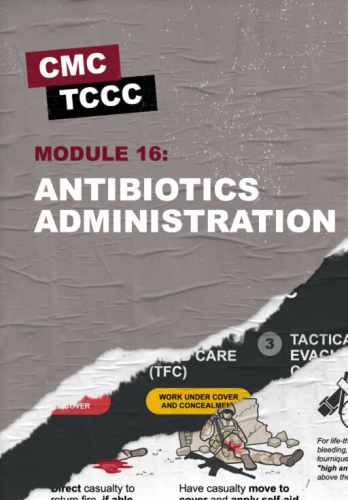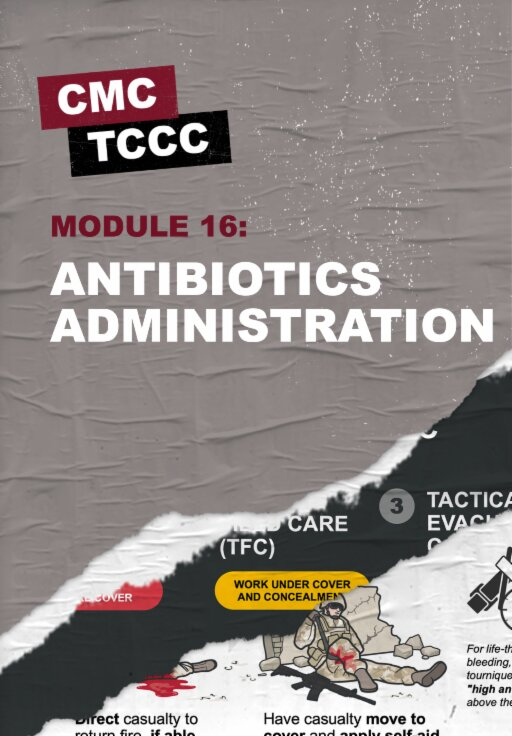Support the development of the TCCC project in Ukraine
Module 16: Antibiotics Administration
In this module, we will discuss the use of antibiotics appropriate for the Tactical Field Care phase of TCCC. In general, antibiotics are given as soon as possible for all open wounds.
Antibiotic Administration

This module discusses antibiotic indications and administration in the Tactical Field Care (TFC) setting, highlighting the medications you will potentially use as a Combat Medic.
All Service Member and Combat Lifesaver training trains non-medical personnel about the Combat Wound Medication Pack (CWMP) and when to use it, but as a Combat Medic you will have access to additional antibiotic options to consider.

There are 4 cognitive and one performance enabling learning objectives covered in this module.
The identification and significance of early antibiotics and the methods of antibiotic administration will be reviewed. Specific consideration of the indications and contraindications for oral moxifloxacin and parenteral ertapenem will also be discussed.
The performance learning objective will target the preparation and administration of antibiotics in a Tactical Field Care setting.
Antibiotics are the second “A” in the MARCH PAWS sequence.
Although penicillin was discovered in 1928, it took over a decade before it was being looked at as a potential solution for a wide variety of infections. At the beginning of World War II, drug companies, supported by the War Production Board, developed processes to scale up production; and by 1943-1944 penicillin was reaching forward military locations.
Soon afterward, later in 1944, the first publication demonstrating the improved outcomes of soldiers treated at the surgical units closest to the front was published. Anecdotal and retrospective reviews throughout subsequent conflicts continued to confirm that delaying treatment until casualties arrived at rear hospitals led to worse outcomes, and recommendations were for field administration, if evacuation times were delayed by several hours.
During the 1993 battle of Mogadishu, a 15-hour delay without antibiotics before treatment at a forward surgical facility resulted in wound infections in 16 of the 58 casualties, for an infection rate of 28%. Subsequently, battlefield antibiotics were recommended in the first TCCC Guidelines.
Later, at the beginning of the war in Iraq, 32 casualties from the drive to Baghdad at the start of the war received early antibiotics on the battlefield and a negligible rate of infections was achieved, despite casualty evacuation often being delayed. And in a separate review of 19 Specials Forces medics and 30 Iraqi military forces treated with antibiotics on the battlefield, no infections were noted despite an 11-hour delay in evacuation.
Animal models have also validated that antibiotics must be given as soon as possible after injury to maximize their ability to prevent wound infections. In one study, for example, a delay of 6 hours had a profound detrimental effect on the infection rate compared to early administration, regardless of the timing of surgery.
A 2007 review of TCCC as used on the battlefields of the Global War on Terrorism noted that there were no reports of adverse effects from the use of battlefield antibiotics, speaking to the safety profile of early administration of antibiotics.
Although antibiotics are not used in most civilian prehospital emergency medical systems with short transport times, definitive care for casualties may be significantly delayed in combat settings due to the longer distances to be covered and tactical constraints on evacuation assets. Antibiotics must be given as soon as possible after injury to maximize their ability to prevent wound infections.
Antibiotics are indicated in all open wounds, regardless of the mechanism of injury. Proper wound care, including irrigating the wound, should be performed; but even when wounds are properly treated, antibiotics should be initiated.
Highlighting this issue, it should be noted that extremity injuries have been prevalent in recent conflicts and infections have caused significant morbidity. For example, osteomyelitis has been reported in up to 9% of type III tibia fractures, and extremity infections have led to decreased success in limb salvage, an increase in additional surgical procedures and late amputations, as well as a decrease in the likelihood of the casualty being able to return to duty.
As just mentioned, the safety profile of both oral and parenteral antibiotics on the battlefield has been very good, and the only contraindication is a known drug allergy. As with any medication, there is a small risk of an adverse drug reaction that would require management, but to date that has rarely happened, and the benefits of early infection prevention far outweigh the small risk of an adverse reaction.
One of the considerations in choosing the best antibiotic is the need for effectiveness across a broad range of pathogens, as opposed to the process of choosing antibiotics in a normal clinical setting where you use the wound site, potential pathogens known to exist in the environment, and the patient’s health status to determine the best treatment choice. Also, a desire for minimal side effects, environmental stability, simple and infrequent dosage regimens, and comparatively low cost are all important considerations.
Since 2002, fourth-generation fluoroquinolones have been the oral antibiotic of choice. The second-generation cephalosporin cefotetan was initially the parenteral antibiotic of choice, but in 2011 ertapenem (a carbapenem antibiotic) was added as an alternative option, and then in 2017, ertapenem became the antibiotic of choice. Ertapenem and moxifloxacin are not ideal prophylaxis for every type of wound, but they are safe and effective broad-spectrum antibiotics. They are also recommended for prehospital care of penetrating wounds of the chest or abdomen in the current Joint Trauma System Infection Prevention Clinical Practice Guideline.
The two methods of administering antibiotics in the tactical setting are by mouth or by parenteral (intramuscular, intravenous, or intraosseous) injection.
The logistical issues associated with carrying, reconstituting, and then injecting or infusing parenteral medications make use of oral antibiotics the preferred route, when oral administration is possible.
Parenteral administration of antibiotics is required in casualties who are unconscious or who cannot take medications by mouth (for example, due to maxillofacial injuries). It is also required for casualties in shock, in whom the gastrointestinal tract blood flow may be inadequate for absorption of oral medications.
Prophylactic antibiotic therapy should be accompanied by wound irrigation, surgical debridement of the wound when the situation permits, immunization for tetanus, and appropriate post-surgical care of the wound in order to minimize the risk of wound infection.
This video will recap some of the important concepts of antibiotics in the Tactical Field Care setting.
ANTIBIOTIC ADMINISTRATION OVERVIEW
If the casualty is not in shock and can swallow oral medications, they should be given a 400 mg tablet of moxifloxacin. This is the dose found in the casualty’s Combat Wound Medication Pack (or CWMP). Advise them to take it with water and be sure to document the time of administration on their DD Form 1380, TCCC Casualty Card.
Moxifloxacin is available in PO form and is recommended for all open combat wounds if the casualty is able to take PO medications.
Contraindications include; quinolone hypersensitivity, hepatic insufficiency, syphilis, arrhythmias, myocardial ischemia or infarction, QTc prolongation, hypokalemia, or those receiving Class IA or Class III antiarrhythmic drugs, potential benefits may warrant use in pregnant women despite potential risks if the alternative is worse.
Potential side effects of moxifloxacin include; dizziness, headache, peripheral neuropathy, nausea, diarrhea, abdominal pain, vomiting, taste perversion, abnormal LFTs, dyspepsia, and tendon rupture.
Drug interactions include; iron, zinc, antacids, aluminum, magnesium, calcium, and sucralfate decrease absorption, atenolol, cisapride, erythromycin, antipsychotics, TCAs, quinidine, procainamide, amiodarone, sotalol may prolong QTc interval, may cause false positive on opiate screening tests
The Onset/Peak/Duration for moxifloxacin is 1 hr/2 hr/20-24 hr.
The casualty should use their own medication, unless for some reason they no longer have access to their own CWMP.
Moxifloxacin has excellent intraocular penetration when taken systemically (as opposed to other antibiotics which require intravitreal injection) and is effective for most gram-positive and gram-negative bacteria that might cause post-injury endophthalmitis, which is another advantage when dealing with eye injuries.
Other fluoroquinolones may occasionally be found at forward locations, but moxifloxacin is the quinolone of choice at this point. Gatifloxacin was previously recommended, but was later reported to cause disorders of glucose metabolism and was subsequently replaced. And levofloxacin has been considered based on its effectiveness against gram-negative bacteria; but with some recent increase in drug-resistant strains, no change has been recommended.
Individuals with known medication allergies to the fluoroquinolone class of medications should be identified, as they may require a different class of antibiotics. Examples of this include the two just mentioned, gatifloxacin and levofloxacin, as well as ciprofloxacin. You should screen your troops for medication allergies prior to deploying, when you provide them with Combat Wound Medication Packs, and be aware of any allergies that members may have to medications recommended in the TCCC Guidelines. If an individual should not take moxifloxacin, consult with your medical officer to determine the appropriate substitute antibiotic.

If the casualty is in shock or unconscious, or cannot swallow oral medications, they should be given one gram of ertapenem. This can be administered by intramuscular, intravenous, or intraosseous injection. As with any medication or treatment, the medication, dose, and the time of administration should be documented on the DD Form 1380.
Ertapenem is recommended for all open combat wounds if the casualty is unable to take PO medications.
Ertapenem is a member of the carbapenem family of the beta-lactam class of antibiotics. As such, it is contraindicated in persons with known anaphylactic reactions to other beta-lactams including penicillins and cephalosporins. Also, since ertapenem is reconstituted with lidocaine for IM injection, it cannot be given IM to persons with known hypersensitivity to lidocaine. As with moxifloxacin, if an individual in your unit should not take ertapenem, consult with your medical officer to determine the appropriate substitute antibiotic.
Potential side effects include; injection site phlebitis or thrombosis, asthenia, fatigue, death, fever, leg pain, anxiety, altered mental status, dizziness, headache, insomnia, chest pain, hypo- or hypertension, tachycardia, edema, abdominal pain, diarrhea, acid reflux, constipation, dyspepsia, nausea, vomiting, increased LFTs, cough, dyspnea, pharyngitis, rales, rhonchi, respiratory distress, erythema, pruritus, and rash.
Drug interactions include; probenecid decrease renal excretion.
The Onset/Peak/Duration for ertapenem is 30 sec-5 min/30 min-2 hr/24hr.
Ertapenem should not be mixed or co-infused with other medications to prevent crystallization and should not be mixed with diluents containing dextrose. It may be administered intramuscularly (IM) if needed. However, in that case it should be reconstituted with 3.2 mL of 1.0% lidocaine HCl (without epinephrine), instead of saline or bacteriostatic water.
Ertapenem became the parenteral antibiotic of choice based on its once-a-day dosing, its excellent broad-spectrum coverage, and its good safety profile.


PDF Antibiotic Administration Cheat Sheet

This module provided you a good overview of antibiotics in Tactical Field Care.
The importance of using antibiotics early in battlefield wounds and the general indications and methods of antibiotic administration were reviewed.
The indications and considerations for administering moxifloxacin and ertapenem were also discussed.
To close out this module, check your learning with the questions below (answers under the image).
Check on learning
Answers
What is the oral antibiotic of choice and its dose?
If the casualty is not in shock and can swallow oral medications, they should be given a 400 mg tablet of moxifloxacin.
When should you use ertapenem instead of moxifloxacin as an antibiotic therapy?
If the casualty is in shock or unconscious, or cannot swallow oral medications, they should be given one gram of ertapenem.
What are the advantages of using an oral antibiotic over a parenteral antibiotic?
The logistical issues associated with carrying, reconstituting, and then injecting or infusing parenteral medications makes use of oral antibiotics the preferred route, when oral administration is possible.
When should you administer antibiotics in the Tactical Field Care phase?
Antibiotics must be given as soon as possible after injury to maximize their ability to prevent wound infections.

You can discuss this material on the TCCC forum






























